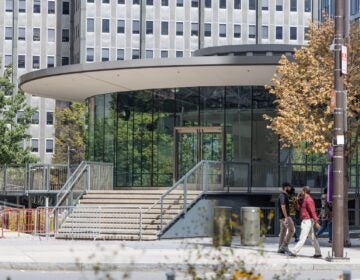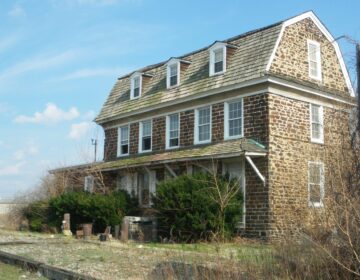Behind the scenes on riverfront warships
John Fischer photo
June 6
By Linda K. Harris
For PlanPhilly
Two historic ships, one that represents America’s debut as a world power and the other a symbol of its eminence, hug the shoreline on the banks of the Delaware River, absorbing the wake of more active ships that pass by, stately still in their distinguished retirements, and amenable to visitors and the curious.
The USS Olympia, flagship for the Spanish-American War, which snuffed out the last of the Spanish Empire holdings and gave rise to America’s international prominence, and the submarine Becuna, which patrolled the Pacific Ocean during World War II, sit afloat just south of the Independence Seaport Museum, which is in charge of their care and maintenance. Both ships are designated National Historic Landmarks.
On the first Saturday of each month, the museum offers a dream tour for “old salts,” steam engine aficionados, history buffs and anyone fascinated by machines and how they work.
The museum’s “Behind the Scenes Tour” takes you down nearly three dozen narrow, metal-grill steps, deep into the bowels of the 344-foot Olympia, for a close-up inspection of two-ton piston heads, exquisitely crafted gears, rods, tubes and levers, and hand-oiled walnut casings of two notable 3-cylinder triple-expansion steam engines that powered what has become the oldest surviving steel warship afloat in the world.
“This old girl was a beautiful piece of machinery,” said tour guide Harry Burkhardt, 50, a former U.S. Coast Guard petty officer and now a captain on a Philadelphia Water Department trash-skimming boat that helps clean up the Delaware River.
Nearly all of Burkhardt’s free time is spent as a volunteer restoring, polishing and cleaning the Olympia’s statuesque starboard and port engines with a combined weight of 1,239 tons. (By comparison, a giant sperm whale weighs a mere 40 tons.)
Burkhardt tells the crowd that he takes to heart “the guidelines of preservation that say anything that can be operated should be operated,” anything that moves, should move.”
“I’m the steam engine whacko,” he says, with a bit of old-salt humor.
The USS Olympia, built in San Francisco at a cost of $1,796,000, was launched in 1892. It was part of a plan to update the U.S. Navy and develop West Coast shipbuilding, said Jesse Lebovics, manager, Olympia/Becuna at the Independence Seaport Museum.
After the Spanish-American War of 1898, “we became a contender on the world stage,” Lebovics said. “We had been an ex-colony. We were Australia or Indo-China. The Olympia became a floating symbol of American naval power.”
Spain had controlled the Philippines for 375 years when the United States wrested control.
As the museum’s website points out, the Olympia’s role in the war of 1898 also brought fame to Commodore George Dewey, noted in naval lore for his remark, “You may fire when you are ready, Gridley.”
The Olympia was refitted and became part of the fleet that participated in World War I. In 1921, the steel ship performed its last official act, bringing home the body of the Unknown Soldier from France for burial in Arlington National Cemetery. For further details, go to www.hnsa.org/ships/olympia.htm.
In addition to its national historical designation, the American Society of Mechanical Engineers designated the Olympia as a National Historical Mechanical Engineering Landmark in 1977 for its vertical reciprocating steam engines, considering masterpieces in their time.
For a detailed description of the engines, photos and other interesting details, go to
http://files.asme.org/ASMEORG/Communities/History/Landmarks/5611.pdf.
The Olympia was indeed a grand ship with room for 34 officers and nearly 400 sailors. The Officers’ Country quarters were small but fairly elegant, outfitted with oak chests and armoires and each supplied with a typewriter. Peering through the door window of one of the rooms, you can almost imagine a harried officer typing out his report.
But Saturday’s tour wasn’t about the living quarters, the mess or the heads, it was about the brilliantly constructed hardware that sat just below the waterline in the ship’s protected hull. That’s what brought the visitors out on a hot, steamy day, prematurely summer, with the mercury hovering close to 90 degrees.
Joseph Forgeng, 81, of Huntingdon Valley, and his grandson, the U.S. Navy’s Lieutenant Junior Grade David Forgeng, 25, stayed with the tour all the way down through the boiler room, where soft bituminous coal lay on the floor for a touch of authenticity.
The boiler room, also known as “the bowels of hell,” according to Burkhardt, inspires awe. Under full speed of 22 knots, about 25 miles per hour, the Olympia devoured 20 tons of coal every hour, and carried enough onboard to last three months, Burkhardt said. Temperatures inside the boiler room were so intense, work shifts were limited to four hours, he said.
The Forgengs’ fascination with the ship was understandable. Joseph Forgeng is a retired manufacturing engineer, and his grandson, stationed in Charleston, S.C., is studying nuclear power.
The elder Forgeng found the tour “one of the most fascinating things I’ve ever seen” while his grandson termed it “amazing.”
If climbing down three flights of narrow metal stairs on the Olympia seemed precarious, the visitors to the Becuna found themselves in even more dubious places. Anyone with even a touch of claustrophobia would instantly go into freakout mode on a tour of the submarine Becuna.
For many people, knowledge of submarines is limited to what they read in “Run Silent, Run Deep,” a classic submarine war novel written by Edward L. Beach. The book was made into a successful movie in 1958, starring Burt Lancaster and Clark Gable, forever ensuring the immortality of terms such as depth charge and phrases such as “Man the torpedoes” and “Up Periscope!”
On Saturday, it was substantially less dramatic. However, one needed only a little imagination to realize that in a ship 307 feet long, with 90 people inside, you wouldn’t need an enemy chasing you at ocean depths of 400 feet for issues to arise.
“They were all volunteers,” explained Bill Bustard, an architectural draftsman from Oreland, Pa., who served as tour guide. “They would give them a battery of tests.”
Those who were chosen to serve on the submarines were rewarded with better pay and the best food available, Bustard said. “They would have steak, ice cream, what was available.” No alcohol was allowed, but even in these tight quarters smoking was permitted.
“Everybody smoked in those days,” Bustard said, even though the sailors lived in what can only be described as a large metal tube, painted gray and black and lined with dials, levers, gizmos, gadgets, every square inch of the walls covered with mechanical devices, and carrying a load of 24 torpedoes!
The dining room or mess served 24 men at a time, with tabletops decorated with backgammon and checker boards. The kitchen next door helped you realize the origins of the the real-estate term “galley kitchen.”
Bustard showed the group the gyroscopes, compasses and a bubble gage, which measured the angle of ascent. The bubble gage inspired the name “Bubbleheads” for men who served on the submarines.
Bubbleheads must have been some of the most agile people around because scampering up a ladder with stingy side rails to the Conning Tower involves a lot of groping and hoping. There’s no taking notes when one attempts this. But the instructions were something like this: Put your foot there, grab the edge, pull yourself up, grab the other edge, turn… you get the idea.
The reward is a chance to peer through the iconic symbol of the submarine: the periscope. You might not spot any enemy ships, but you can turn the handles and wait, what’s that! Oh, it’s just cars speeding past and a green highway sign that reads in large letters: Interstate 95 North. Oh well.
“The significance of the Becuna can’t be underestimated,” Lebovics said, standing before the memorial outside to the 52 submarines lost in World War II. The tribute salutes the men “Still on Patrol,” the Navy’s term for those who died in the dark and murky waters of the world’s seas.
Though Becuna tour-guide Bustard never served on a submarine, he said he was always reading about them. “The equipment is fascinating,” he said.
The Becuna and the USS Olympia are just two of Philadelphia’s historic treasures, at home along the Delaware River, one of the city’s greatest assets.
Penn Praxis, the clinical arm of the School of Design of University of Pennsylvania, is continuing its study of how best to preserve and improve the Delaware River waterfront and its many jewels, and will present its findings this fall. Making people aware of the waterfront’s treasures is also part of its mission.
If you’d like to take the “Behind the Scenes” tour of the USS Olympia and Becuna, keep in mind it’s not recommended for children under 12, and there are many steps to climb involving a fair amount of physical exertion. Wear close-fitting clothes, and women, dresses will not do!
Here are the forthcoming dates for tours, all of which begin at 12 noon:
Saturday, July 7
Saturday, Aug. 4
Saturday, Sept. 1
Saturday, Oct. 6
Saturday, Nov. 3
Saturday, Dec. 1
Admission is $9 for adults, $6 for children, $8 for seniors and students with valid school ID. The
Independence Seaport Museum is located at
211 S. Columbus Blvd.
For more information, go to www.phillyseaport.org, and for a virtual tour, click on “Ships.”
Linda K. Harris is a former writer and editor for The Philadelphia Inquirer. She lives in South Philadelphia.
WHYY is your source for fact-based, in-depth journalism and information. As a nonprofit organization, we rely on financial support from readers like you. Please give today.






